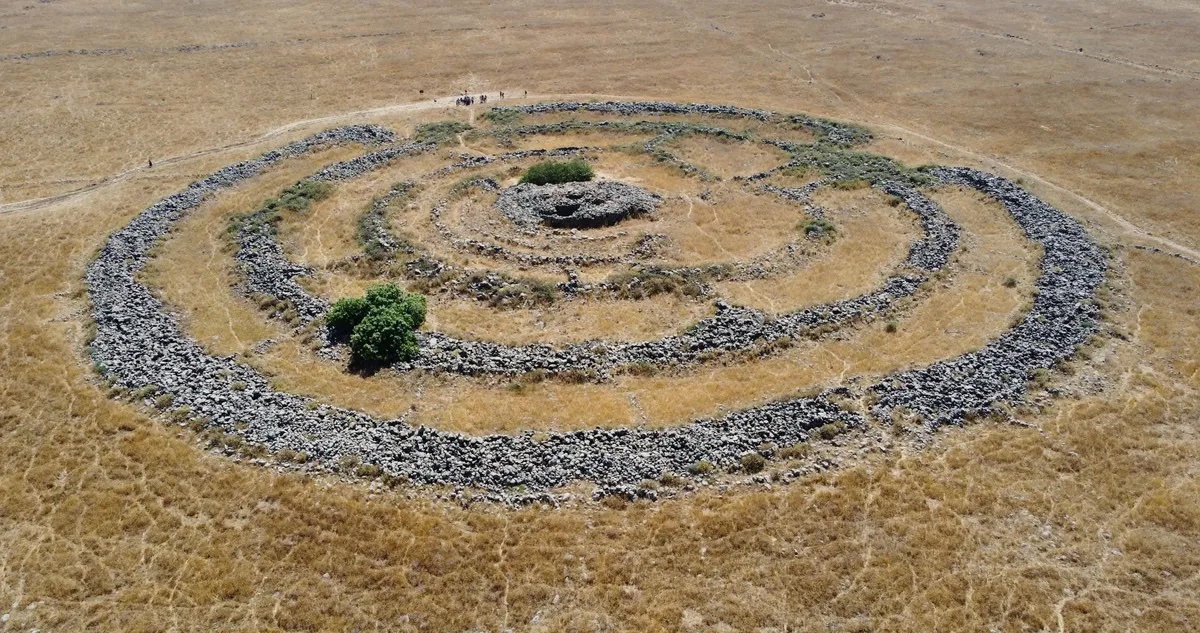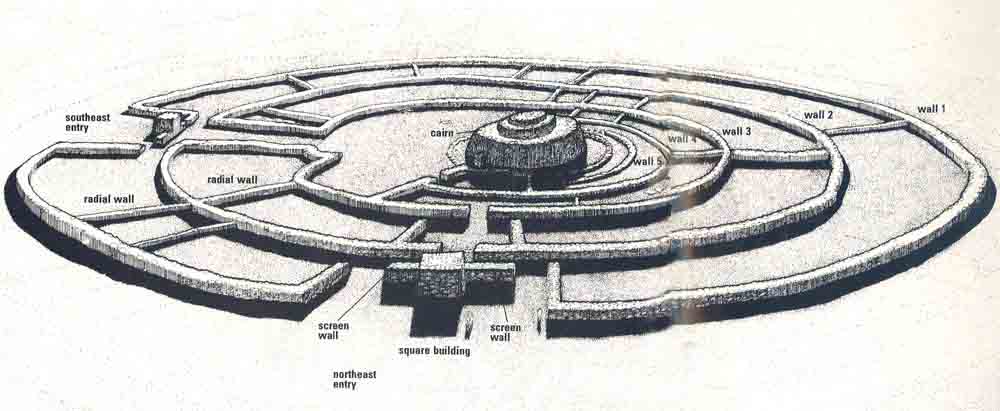

Gilgal Refa'im or Rujm el-Hiri is an ancient megalithic monument in the Golan Heights (Early Bronze Age II, 3000-2700 BCE)
Rujm el-Hiri consists of concentric circles of stone with a tumulus at center. It is located in the Golan Heights some 16 kilometres (9.9 mi) east of the coast of the Sea of Galilee, in the middle of a large plateau covered with hundreds of dolmens.
Made up of more than 42,000 basalt rocks arranged in concentric circles, Rujm al-Hiri has a mound 15 feet (4.6 m) tall at its center. Some circles are complete, others incomplete.
The outermost wall is 520 feet (160 m) in diameter and 8 feet (2.4 m) high. The establishment of the site, and other nearby ancient settlements, is dated by archaeologists to the Early Bronze Age II period (3000-2700 BCE).
Since excavations have yielded very few material remains, Israeli archeologists theorize that the site was not a defensive position or a residential quarter but most likely a ritual center featuring ritual activity to placate the gods, or possibly linked to the cult of the dead. However, there is no consensus regarding its function, as no similar structure has been found in the Near East.
The name Rujm el-Hiri, "stone heap of the wildcat", was originally taken from Syrian maps. The term rujm in Arabic can also refer to a tumulus, a heap of stones underneath which human burial space was located. The name is sometimes romanized as Rujm Hiri or Rujum al-Hiri.
Rogem Hiri is a Modern Hebrew of the Arabic name Rujm el-Hiri. A modern Hebrew name used for the site is Gilgal Refaʾim "Wheel of Spirits" or "Wheel of Ghosts" as refa'im means "ghosts" or "spirits".
The site's size and location, on a wide plateau which is also scattered with hundreds of dolmens, means that an aerial perspective is necessary to see the complete layout.
The site was made from Basalt rocks, common in the Golan Heights due to the region's history of volcanic activity. It is made from 37,500-40,000 tons of partly worked stone stacked up to 2 meters (6.6 ft) high. It was estimatedthat the transportation and building of the massive monument would have required more than 25,000 working days.
The remains consist of a large circle (slightly oval) of basalt rocks containing four smaller concentric circles, each getting progressively thinner; some are complete, others incomplete. The walls of the circles are connected by irregularly placed smaller stone walls perpendicular to the circles.
The central tumulus is built from smaller rocks and is thought to have been constructed after the surrounding walls. Connecting to it are four main stone walls. The first wall, shaped like a semicircle, is 50 m in diameter and 1.5 m wide.
That wall is connected to a second one, an almost complete circle 90 m in diameter. The third wall is a full circle, 110 m in diameter and 2.6 m wide. The fourth and outermost wall is the largest: 150 m in diameter and 3.2 m wide.
A central tumulus 65 feet (20 m) in diameter and 15 feet (4.6 m) high is surrounded by concentric circles, the outermost of which is 520 feet (160 m) in diameter and 8 feet (2.4 m) high.
Two entrances to the site face the northeast (29 meters (95 ft) wide) and southeast (26 meters (85 ft) wide). The northeast entrance leads to an access-way 20 feet (6.1 m) long leading to the center of the circle which seems to point in the general direction of the June solstice sunrise. The axis of the tomb discovered at the site's center is similarly aligned. Read more ...

What Was The Ancient "Wheel Of Ghosts" - AKA "Stonehenge Of The East"? IFL Science - January 1, 2025
The mystery surrounding one of the largest megalithic monuments in the Middle East has deepened significantly, as new research has just shattered the popular theory that the circular Rujm el-Hiri in the Golan Heights functioned as an astronomical observatory. Also known as the Wheel of Ghosts and the Levantine Stonehenge, this enigmatic labyrinthine structure is thought to be up to 5,000 years old, yet we’re back to square one in terms of understanding why it was built.
Originally uncovered in 1968, Rujm el-Hiri consists of a central cairn surrounded by multiple concentric circles made of basalt stones, connected via a series of radial walls. With a circumference of approximately 500 meters (1,640 feet) and a diameter of 150 meters (492 feet), the massive monument and its purpose have been subject of intense debate for more than half a century.
For instance, some archaeologists believe the Wheel of Ghosts served as a defensive fort, while others suggest it may mark the burial site of an important leader or political figure. Unfortunately, very few artifacts have been recovered from within the structure, which means researchers have virtually no clues to work with.
However, in 1998, a study came out that showed that Rujm el-Hiri’s symmetry axes and entrances were aligned to the directions of the solstices, equinoxes, Sirius, and other celestial bodies as they would have appeared in the Bronze Age sky. This led to the widespread belief that the ancient monument served as an astronomical observatory.
To investigate whether this was indeed the case, the authors of a new study analyzed the tectonic movements of the area around the Sea of Galilee over the past 150 million years. According to the researchers, “the tectonic blocks of northern Israel have continuously moved along an elliptical trajectory in a counterclockwise direction” at an average rate of between 8 and 15 millimeters (0.3 to 0.6 inches) per year.
As a consequence, Rujm el-Hiri is likely to have rotated by about 40 meters (131 feet) over the past 4,000 years, which means its axes, entrances, and other features were originally constructed far from their current location.
The region’s integrated geophysical analysis reveals that the Rujm el-Hiri site has rotated counterclockwise and shifted from its original location by tens of meters. This means that the current orientation of the radial walls and entrances was not the same as ~ 4000-2000 BCE, and the speculations that they were aligned with celestial bodies of the past are not supported. Therefore, Rujm el-Hiri was unlikely an observatory.
Exactly why the enormous ring was built therefore remains a complete mystery, although it’s intriguing to note that earlier this year, archaeologists in Crete discovered a remarkably similar circular labyrinth from roughly the same period in history. Attributed to the Minoan civilization, this perplexing structure is just as mysterious as the Wheel of Ghosts, although researchers believe it may have acted as a ceremonial space where ritual offerings and feasts were conducted.